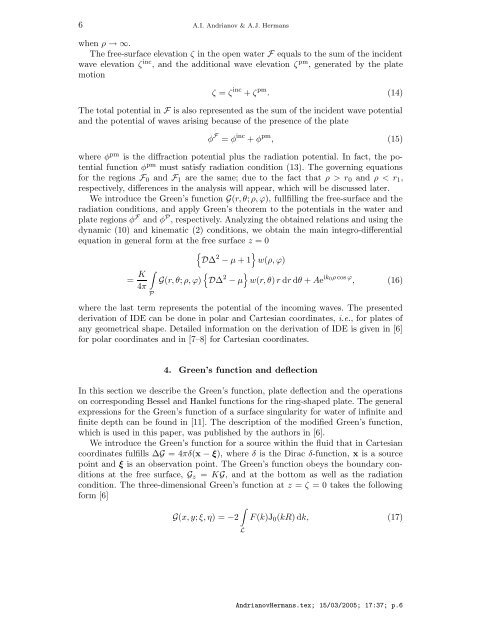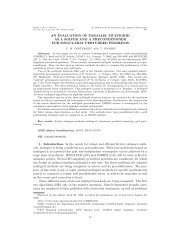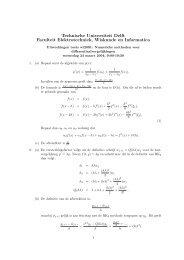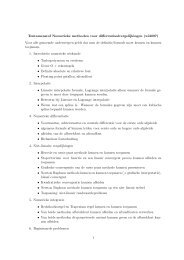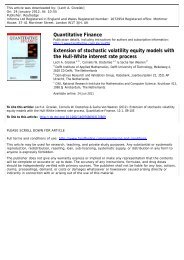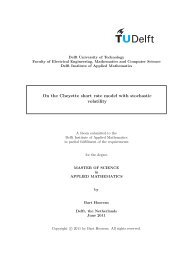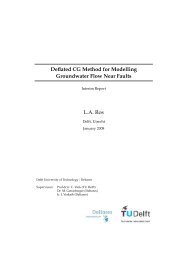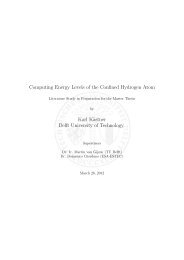Hydroelastic behavior of a floating ring-shaped plate
Hydroelastic behavior of a floating ring-shaped plate
Hydroelastic behavior of a floating ring-shaped plate
Create successful ePaper yourself
Turn your PDF publications into a flip-book with our unique Google optimized e-Paper software.
6 A.I. Andrianov & A.J. Hermanswhen ρ → ∞.The free-surface elevation ζ in the open water F equals to the sum <strong>of</strong> the incidentwave elevation ζ inc , and the additional wave elevation ζ pm , generated by the <strong>plate</strong>motionζ = ζ inc + ζ pm . (14)The total potential in F is also represented as the sum <strong>of</strong> the incident wave potentialand the potential <strong>of</strong> waves arising because <strong>of</strong> the presence <strong>of</strong> the <strong>plate</strong>φ F = φ inc + φ pm , (15)where φ pm is the diffraction potential plus the radiation potential. In fact, the potentialfunction φ pm must satisfy radiation condition (13). The governing equationsfor the regions F 0 and F 1 are the same; due to the fact that ρ > r 0 and ρ < r 1 ,respectively, differences in the analysis will appear, which will be discussed later.We introduce the Green’s function G(r, θ; ρ, ϕ), fullfilling the free-surface and theradiation conditions, and apply Green’s theorem to the potentials in the water and<strong>plate</strong> regions φ F and φ P , respectively. Analyzing the obtained relations and using thedynamic (10) and kinematic (2) conditions, we obtain the main integro-differentialequation in general form at the free surface z = 0{}D∆ 2 − µ + 1 w(ρ, ϕ)= K ∫{ }G(r, θ; ρ, ϕ) D∆ 2 − µ w(r, θ) r dr dθ + Ae ik 0ρ cos ϕ , (16)4πPwhere the last term represents the potential <strong>of</strong> the incoming waves. The presentedderivation <strong>of</strong> IDE can be done in polar and Cartesian coordinates, i.e., for <strong>plate</strong>s <strong>of</strong>any geometrical shape. Detailed information on the derivation <strong>of</strong> IDE is given in [6]for polar coordinates and in [7–8] for Cartesian coordinates.4. Green’s function and deflectionIn this section we describe the Green’s function, <strong>plate</strong> deflection and the operationson corresponding Bessel and Hankel functions for the <strong>ring</strong>-<strong>shaped</strong> <strong>plate</strong>. The generalexpressions for the Green’s function <strong>of</strong> a surface singularity for water <strong>of</strong> infinite andfinite depth can be found in [11]. The description <strong>of</strong> the modified Green’s function,which is used in this paper, was published by the authors in [6].We introduce the Green’s function for a source within the fluid that in Cartesiancoordinates fulfills ∆G = 4πδ(x − ξ), where δ is the Dirac δ-function, x is a sourcepoint and ξ is an observation point. The Green’s function obeys the boundary conditionsat the free surface, G z = KG, and at the bottom as well as the radiationcondition. The three-dimensional Green’s function at z = ζ = 0 takes the followingform [6]∫G(x, y; ξ, η) = −2 F (k)J 0 (kR) dk, (17)LAndrianovHermans.tex; 15/03/2005; 17:37; p.6


